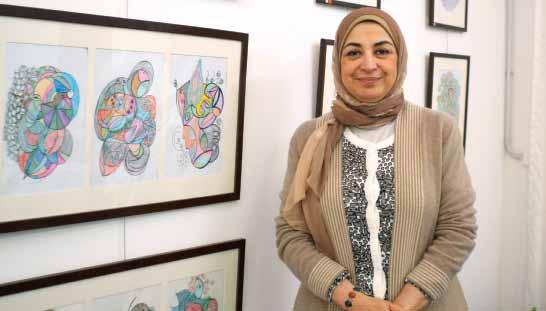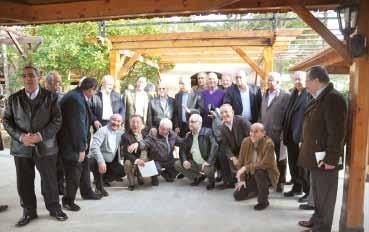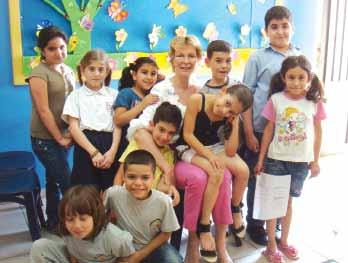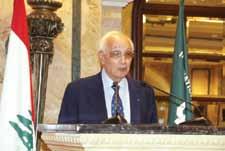
10 minute read
Just a few more months
Flansburgh President David Croteau, Trustee Maya Tohme, Trustee Imad Taher ’58, President John Johnson, Senior VP Mishka Mourani

Mishka Mourani and David Croteau There’s a palpable sense of something in the air these days around IC. Relief for some; anticipation for others; excitement for many. All eyes and thoughts are only on one thing: the new IC elementary school buildings will be completed and handed over in October 2012 – only a few short months away.
How it all began…
It all started in 2009 when after 10 years of negotiations with AUB, the IC Ras Beirut campus was purchased. This effectively meant that IC was now free to make any changes it saw fit. The Reynolds Hall – formerly the British Embassy – was to be transferred to AUB. IC desperately needed a new elementary school. In anticipation, IC had already been working on a master plan for the entire campus. Once the purchase was finalized, the school’s Buildings and Grounds Committee started the search for the right architectural firm. In 2008, Flansburgh Architects, a US firm specializing in the design of educational institutions, was hired. Joined by local architectural firm, Khatib and Alami, they unveiled their design which consisted of three buildings – North and West would be used for classrooms while the South would house recreational facilities (including an indoor gym and theatre) that would serve the entire student body. The South Building would also house the school’s central plant. Moreover, the buildings would be LEED certified (authenticated to be environmentally friendly) with a Gold rating. The committee literally poured over the designs for weeks on end. There were many decisions to take. “Tough decisions,” recalled Imad Taher ‘58, Chair of the Buildings and Grounds Committee, “every step of the way.” Consultants were called in and architects were extensively questioned. These buildings were like no other. These are
structures that must be built around the school’s existing educational program – a move that would be changing the standards in IC’s educational system. The committee studied every aspect conceivable. Was something missing? Do these plans project the needs of the school for the future? Do they preserve the natural environment? “The most difficult decision was actually to agree on a conceptual design because this was the defining moment,” said Taher. “Once you accept the final design you are hooked to that. It is irreversible.” Finally, the design was deemed perfect. The Board gave its approval. In November 2010, the ground was broken. There was no going back. And so began IC’s first major construction project since a century ago. “Do I feel a little anticipation?” said Taher. “Of course. There’s always a little apprehension to see whether the result will come out exactly as you had envisioned. But I feel that we are watching a new transformation for IC and these buildings are the first landmarks of this big change.”
Money – lots of it - would help…
In 2009, the Partnership for Excellence Campaign was launched. The goal was to raise $55m not only to cover the cost of the new elementary school, but also to finance a master plan which would include the renovations of the IC’s historical buildings and the building of a new middle school. Another master plan is being drawn up for the Ain Aar campus. Alumni, parents, and IC friends were approached. It was essentially up to them to fund to the project. Enter Vice President for Alumni and Development, Moufid Beydoun. The 1964 alumnus, a public relations natural, was tasked with the challenge. And so the travels began and still continue. Every few months, Beydoun - frequently accompanied by IC President John Johnson - heads to the US, Europe, and the Arab countries. Many alumni reunions and meetings are held. Speeches are given and pledges collected (see Development section). “It’s worth it,” said Beydoun, who despite the hectic traveling schedule always seems jovial. “This is something that I have been dreaming about for a long time. We worked on it so much that I never thought it would actually happen.” Far from being disturbed by the construc-

tion racket just beyond his office window, Beydoun smiled contently. “I’m very proud,” he said, “especially that a good part of my work was to help secure the financing of these buildings. They are our babies.”
Thousands of hours later….
On the last floor in Thomson Hall, Johnson and Senior Vice President, Mishka Mourani, are conferring in the president’s office. The mundane budget talks aside, they are continuing the never-ending discussions about the new elementary school. Over the past two years, Johnson has become well versed in every detail of the new buildings – he had to, seeing that his speeches at various IC reunions are instrumental in soliciting the needed funds. Recently, however, he’s been facing another challenge: furnishing the three buildings. For the past few weeks, directors and interior architects (with the advice of international school consultants) have been trying to figure out and choose the suitable fittings and equipment – a rather overwhelming task. “Relief?” he said. “I won’t feel any relief

David Croteau, John Johnson in front of the South Building
until the furniture is in place, the kids are moved in, and all the bugs ironed out.” His eyes suddenly sparkle. “But I am very excited,” he said. “When people see the new school they are going to say: ‘wow’! And then they are going to say: ‘what about the rest of the school?’” Mourani listened attentively. Out of the players in this latest chapter, she is the earliest witness to IC’s modern history. Hired as an English teacher in 1975 when still in college herself, she wore many hats, including the director of the elementary school from 1987 to 1992, and was pivotal in heralding in the latest education methods in IC’s curriculum. In only a few short months, she will be walking into buildings especially designed to fit an education program that she envisioned many years before. “I can’t wait for our kids to move in,” she said. “I’m very excited about it.” At the moment, however, she is still trying to get her head clear of the “thousands and thousands of hours we spent discussing everything from false ceilings to copper piping to PVC”, she said laughing. “I think I will only feel the exhilaration once the building is finally in use.”
Overtime but who’s counting?
But when it comes down to it, the daily grind of moving into the new buildings will fall on the shoulders of current elementary school director, Julia Kozak. It will really be up to her to assess what is working and what isn’t. Only two years ago, she dreaded the move. She had grown to love Reynolds Hall and in fact lovingly made many changes to the old British Embassy building. It didn’t look crowded but “cozy”, as she put it. But as the new buildings began to take shape, she couldn’t help joining in the excitement. Until an unfortunate fall broke her leg a few weeks ago, she was walking daily to the construction site and noting the progress. The work ahead for her and her team is enormous. There will undoubtedly be many overtime hours. “I know there are going to be glitches that come along,” she said. “It’s going to be exhausting and we know it.” Many decisions are still up in the air. Should recess be staggered? Should the schedule change? Many questions will only be clarified once the move is complete. “There are many people with a vast wealth of experience and expertise who are collaborating together to answer concerns and questions,” she said. “It’s going to be great. We have wonderful memories at Reynolds Hall but we will say goodbye and celebrate a new beginning.”
Behind the scenes...
In his workplace – squeezed in the corner of the Alumni office in Thomson Hall – Youssef Abi Abdallah, the Director of Facilities, is swamped with maps. His job is to make sure that designs are executed as planned, on time, and according to the budget. At times, he has been seen smiling widely; other times, he admi-
rably showed much self-restraint. As the deadline of October approaches and everything is going as planned, he seems undeniably relieved. There have been unexpected problems. The ground, for one thing, turned out to be rockier than expected. Delay. Later on, some cavities were discovered. The shoring system had to be redesigned to stabilize the ground. The delay would have been minimal except that the excavators should have had - but did not have - the proper resources on hand. More delay. “It’s a chain reaction,” he said. “If one thing gets delayed then everything else gets delayed. It was very frustrating.” The good news, however, was that no archeological finds were discovered. Although exciting, an archeological find (a possibility in a city continuously inhabited for more than 5,000 years) would have caused a significant setback. Finally, the excavations were over and Abi Abdallah sighed with relief. Unfortunately, the delay in the excavation means that there will be a delay in the construction of one of the buildings. Fortunately, that building– South Building – is for recreational purposes. Classrooms will not be affected. Now, he can focus on implementing the design. Fortunately, the chosen contractor proved to be efficient and well-equipped. “Of course we encountered problems,” he said. “But they are normal construction problems you may have in any construction site.” Any glitches that suddenly appear in the process were effectively the contractor’s domain now. Except for the South Building, it is up to them to deliver the buildings as planned on 1st October, 2012.
And the clock ticks…
In his makeshift white cubicle, tucked into the corner of the construction site - just one of many spread over two floors and comprising the projects’ engineers, architects, safety inspectors, secretaries, and project managers - Richard El Cham, the site’s project manager from MAN Enterprise, seems – well – stressed. The center of his world at the moment is the looming and ever approaching deadline. The clock ticks. “All engineers must report to work on Sundays from now on,” he suddenly declared. He and his team are basically in charge of the project from A to Z, including indoor finishing. “We’ll make it, we’ll make it,” he said nodding emphatically. Still, he admitted, it’s been “stressful”. In a volatile Middle East region, ‘surprises’ can be common but even he didn’t foresee half of his construction workers disappearing when the uprising in Syria began. A large number of the Syrian workforce suddenly fled from Lebanon at one point leaving El Cham with barely a handful of laborers. Lebanese workers apparently refused to replace them. The clock ticks. In desperation, El Cham considered employing Indian workers. Fortunately, after some monetary incentives, El Cham managed to lure his workers back. (Ironically, as the Syrian uprising continued, he later found himself inundated with laborers). To rush things along, he was granted permission to extend working hours until 8pm (instead of 6pm). But neighbors complained and El Cham had to stop. But that clock keeps ticking. More unforeseen problems were encountered. Materials coming from or through Syria could no longer be delivered. The clock ticks. El Cham looked elsewhere. Finally, a sea shipment of much needed gravel just arrived from Greece. He quickly initiated a recovery plan and his 400 or so laborers were put into action. “We’re all on edge now,” he said. “If we were driving a plane before we are driving a rocket now. We are in full acceleration mode.” And the clock ticks…
What excitement?
Unperturbed by the excitement around them, the workers continue their daily tasks. Syrian national Ibrahim Bardawil, 26, shrugged his shoulders nonchalantly. As long as he does a good job here, he knows that MAN will hire him again. “I’ll just move on to another project when this is done.” As for Hassan Sharidi, 32, the end of any project means that he can take a longer holiday in his Syrian hometown with his wife and three children. “But I just have to finish here first,” he said. It’s just another day’s work.
According to the master plan, subsequent phases include the renovation of the existing buildings and the construction of a new middle school, scheduled to begin in 2013. The Ain Aar campus will have its own master plan, which includes the building of an indoor recreational center. For donations to the Partnership for Excellence Campaign, contact Moufid Beydoun at mbeydoun@ic.edu.lb or call: 961 1367420.











